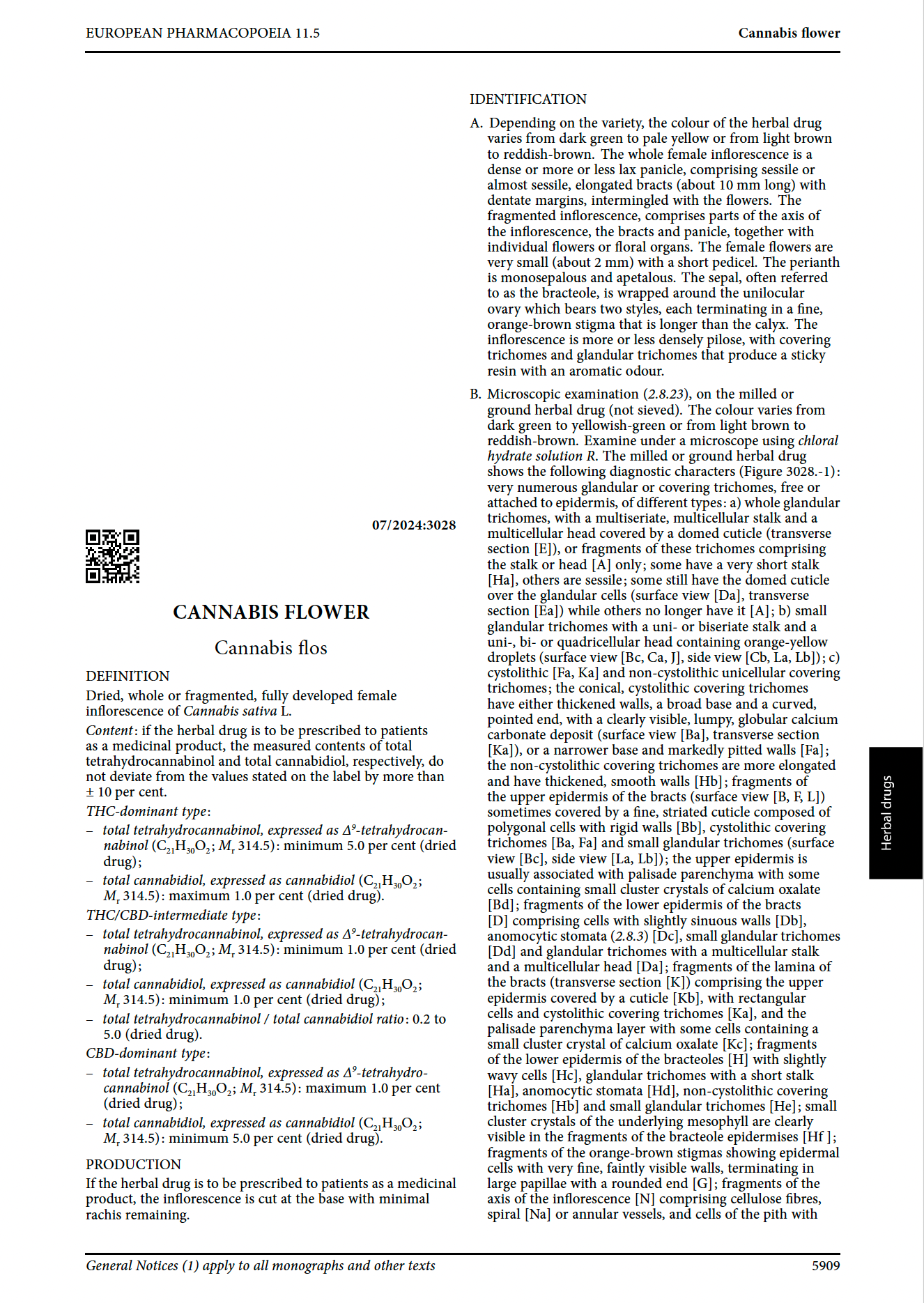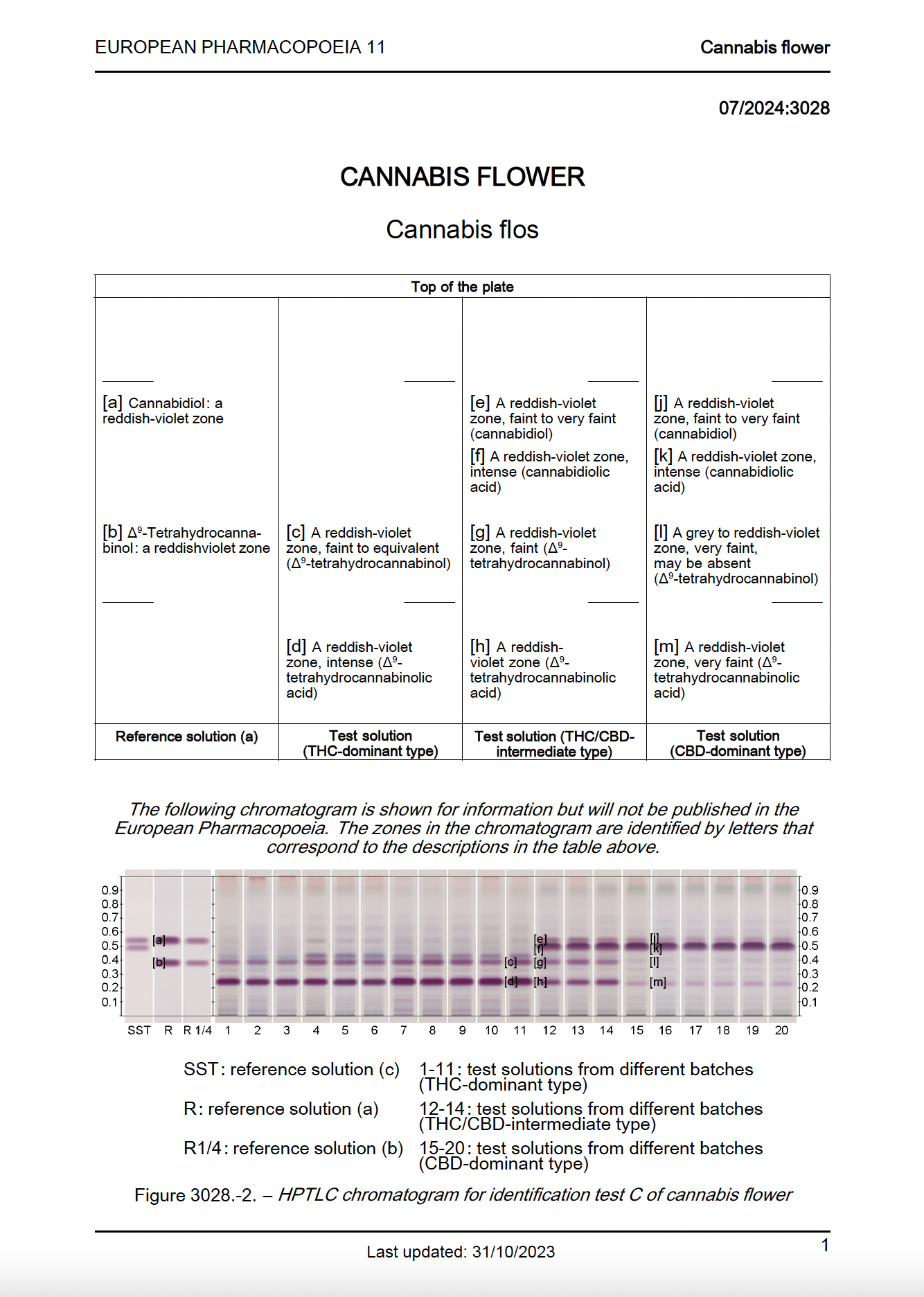Background
 The European Pharmacopoeia published the monograph for cannabis flower (3028) in the Ph. Eur. Supplement 11.5 in January 2024. This update is crucial for stakeholders worldwide, including the Australian medicinal cannabis industry.
The European Pharmacopoeia published the monograph for cannabis flower (3028) in the Ph. Eur. Supplement 11.5 in January 2024. This update is crucial for stakeholders worldwide, including the Australian medicinal cannabis industry.
Coming into force in June 2024, the monograph tightens cannabinoid content deviation and contaminant limits. The European Pharmacopoeia sets legally binding quality standards for medicinal products in Europe, and influences global pharmaceutical practices. The text covers concerns the dried, whole or fragmented, fully developed female inflorescences of Cannabis sativa L; and is complimentary to the general monograph on Herbal drugs (1433) and its additional requirements.
Due to the TGA's general alignment with European Standards, this change may also influence Australia's medicinal cannabis industry, affecting product quality and safety, and also impacting on cost.
Relevance to the Australian Cannabis Industry
Australia's Therapeutic Goods Administration (TGA) adopts the European Pharmacopoeia standards for medicinal cannabis products within Australia, as referenced in TGA Order 93 Section 7. This adherence ensures that medicinal cannabis products produced or supplied in Australia align with internationally recognised quality standards, facilitating both domestic and international trade.
 The recent update to the cannabis monograph (3028) on cannabis flower introduces changes that could influence the Australian medicinal cannabis testing standards:
The recent update to the cannabis monograph (3028) on cannabis flower introduces changes that could influence the Australian medicinal cannabis testing standards:
- 1. Cannabinoid Content Deviation: The update narrows the allowable deviation of cannabinoid content to within 10%, aiming to enhance patient safety by improving the certainty of the potency of THC and CBD. This represents a significant shift from the current 20% deviation allowed by TGA Order 93. Importantly, this updated deviation restriction only applies to the two main cannabinoid active ingredients, THC and CBD.
- 2. Flower Harvesting Requirement: The new guideline requires the removal of as much plant stalk as possible from the female flowers; aiming to reduce the presence of stalks and other foreign matter in the final product.
Stricter Testing Limits: There are now more stringent limits for foreign matter, arsenic, cadmium, and lead (Table 1). These new limits are considerably lower than those currently specified in TGA Order 93, indicating a move towards higher safety and quality standards.
Table 1: Comparison of Test Limits
|
Parameter |
Limit - TGA Order 93 |
Limit - New Ph. Eur. Monograph |
|
Foreign Matter |
2.0% |
2.0% and no presence of seeds or leaves >1.0cm |
|
Arsenic |
3.0 ppm |
0.2 ppm |
|
Cadmium |
0.5 ppm |
0.3 ppm |
|
Lead |
5.0 ppm |
0.5 ppm |
|
Mercury |
0.5 ppm |
0.1 ppm |
Note: ppm (parts per million) in the European Pharmacopeia is equivalent to mg/Kg, as used in TGA Order 93.
What This Means for Australian Medicinal Cannabis
While it remains to be seen whether the TGA will revise TGA 93 to incorporate these new standards, such amendments could significantly impact the Australian medicinal cannabis industry. Stricter quality controls could enhance patient safety and treatment manageability but may also increase production costs, potentially affecting product prices.
We Want to Hear from You
As these changes loom on the horizon, it is vital to gauge their potential impact on the Australian medicinal cannabis landscape. Whether you are a patient, healthcare provider, or industry operator, your insights are invaluable.
How do you think these changes will affect you?
Novachem’s business is supporting analysis and research sciences. We keep our clients and the wider industry informed and prepared for shifts in the regulatory landscape. Your feedback on this article helps us better support industry through these potential changes.
Cannabis Monograph Change Impact Survey
